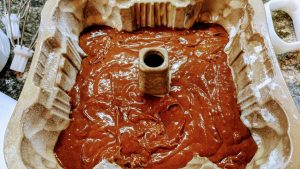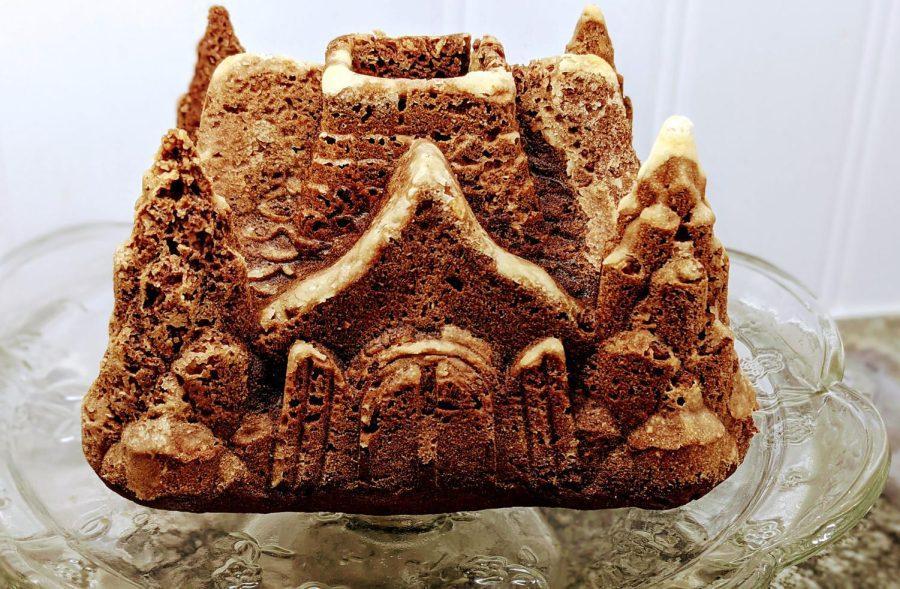Preserved Home: Looking to bake some gingerbread? Snap to it with this recipe
With a deep, spiced flavor and soft crumb, this homemade gingerbread load the perfect holiday breakfast treat. (Photo by Laura Woolfrey Macklem)
December 17, 2021
My daughter asked me to make gingerbread cookies, which I had never made before. Every holiday season, I make gingerbread, but I’ve never made gingerbread cookies.
Some recipes produce crisp cookies fit for a gingerbread house, and others softer and “snap” cookies. Unknowingly, I made a sturdy cookie, and while they tasted good, we had to gnaw on them a bit. I’m not sure milk could even help them.
My gingerbread loaf recipe, though, is a much-anticipated treat and baked in ornamental pans. With a deep, spiced flavor and soft crumb, it’s the perfect holiday breakfast treat. Still, I need to find a good gingerbread cookie.
 Out of all the cookies I’ve made, never have I been perplexed on what the outcome should yield like gingerbread. Come to find out, the history of gingerbread is just as complex, full of folklore, history and culture, delighting children in tales, giving hope to the unmarried, and even being used as a newspaper.
Out of all the cookies I’ve made, never have I been perplexed on what the outcome should yield like gingerbread. Come to find out, the history of gingerbread is just as complex, full of folklore, history and culture, delighting children in tales, giving hope to the unmarried, and even being used as a newspaper.
According to the website The Spruce Eats, “An early European recipe for gingerbread consisted of ground almonds, stale breadcrumbs, rosewater, sugar and, naturally, ginger. The resultant paste was pressed into wooden molds. These carved works of art served as a sort of storyboard that told the news of the day, bearing the likeness of new kings, emperors, and queens, or religious symbols. The finished cookie might be decorated with edible gold paint (for those who could afford it) or flat white icing to bring out the details in relief.”
The roots of this versatile confection can be traced back to the Greeks and Egyptians, who reportedly used these “spiced honey cakes” in ceremonies. Eventually, an Armenian monk named Gregory of Nicopolis introduced gingerbread to Europe in 992. He taught the art of gingerbread to French Christians for seven years, and gingerbread as a consumable art spread throughout Europe with countries and regions taking on their own adaptations.

In Switzerland, it’s called a biber. In the Netherlands, it’s peperkoek or ontbijtkoek. In Poland a pierniki. In Peru, turtă dulce, and in Brazil pão de mel.
I’m starting to think Disneyland should sell versions of these near the “Small World” ride.
England also made quite the to-do about gingerbread. Queen Elizabeth directed her bakers to create gingerbread “biscuits” in caricature form of important guests, giving us the first gingerbread men. Knights were often given gingerbread by their love interests for good luck, and maidens would buy “Gingerbread Husbands” to eat hoping for some good luck of their own in pursuit of betrothal. Gingerbread in a variety of likenesses were so popular at English fairs, the events were dubbed “Gingerbread Fairs.”
From desserts to houses patched together with frosting, America has embraced the world’s timeless affinity for gingerbread. So many cultures have given us versions of gingerbread, perhaps the pursuit of just the right recipe should be year-round.
Gingerbread Loaf
1/2 cup white sugar
1/2 cup softened butter
1 egg
1 cup molasses
2 1/2 cups all-purpose flour
1 1/2 teaspoons baking soda
1 teaspoon ground cinnamon
1 teaspoon ground ginger
1/2teaspoon ground cloves
1/2 teaspoon salt
1 cup hot water
Pre-heat oven to 350 degrees. Cream together sugar and butter. Beat in egg, then add molasses. In a separate bowl, combine flour through salt. Gradually add dry mixture to wet mixture until incorporated. Pour hot water over batter and combine until smooth. Pour in a prepared 8-by-8-inch pan for a tall gingerbread, or use a more shallow ornamental pan coated with cooking spray and flour.
Cooking time is dependent on pan used. For an 8-by-8, the cooking time should be one hour. For shallower pans, 45 minutes or until a toothpick comes from the center clean or with crumbs. Cool for 30 minutes before removing from pan.
For more recipes, tips and details, visit Laura Woolfrey Macklem’s Preserved Home blog at www.preservedhome.com.
Columns represent the views of the individual writer and do not necessarily reflect those of the North Coast Current’s ownership or management.
encinitas current, cardiff current





